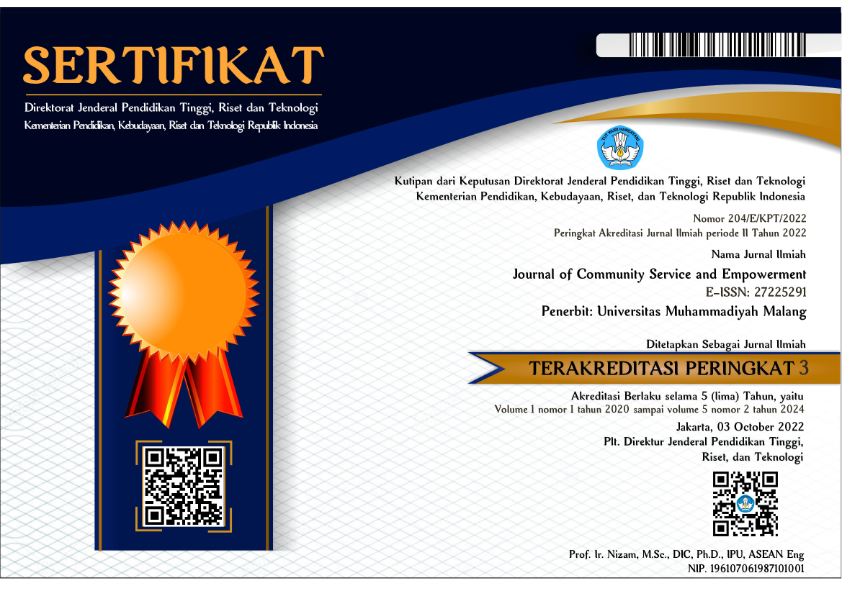Strategy of local government in achieving the target of the long-term contraceptive method program in sukabumi City
DOI:
https://doi.org/10.22219/jcse.v5i2.32348Keywords:
Family planning, Long-Term Contraceptive Method , Population controlAbstract
Long-Term Contraceptive Method is a contraceptive that can be used for a long time, which is more than three years used to delay, minimize pregnancy, and stop fertility, which includes IUD, Implant and steady contraception, this study aims to determine the factors associated with the use of Long-Term Contraceptive Method in Sukabumi City. The purpose of this study is to determine the strategy of the Office of Population Control, Family Planning, Women's Empowerment and Child Protection (DP2KBP3A) in achieving the target of the long-term contraceptive method program in Sukabumi City. This study used descriptive qualitative methods with observational data collection techniques, interviews and documentation. Data analysis was carried out by snowball sampling technique, namely by determining informants who were initially small in number and then enlarged. The results of this study measured by strategy indicators by Mintzberg et al (2003) show that the Agency in achieving the targets of the MKJP program begins with planning, implementing and evaluating. However, in the implementation there are still some obstacles. Existing programs have helped in the process of implementing long-term contraceptive method programs. But not yet fully optimized. Therefore, it is necessary to expand the range of strategies, so that the program of long-term contraceptive methods is maximized.
Downloads
References
Achmad, N. (2020). Implementation of the KB Village Program in Achieving Quality Families in Percut Sei Tuan Deli Serdang Regency. ICOSOP 3 2019 - International Conference on Social Political Development (ICOSOP) 3 The, 317–322. https://doi.org/10.5220/0010018903170322
Alano, A., & Hanson, L. (2018). Women’s perception about contraceptive use benefits towards empowerment: A phenomenological study in Southern Ethiopia. PLoS ONE, 13(9), 1–15. https://doi.org/10.1371/journal.pone.0203432
Britton, L. E., Alspaugh, A., Greene, M. Z., & McLemore, M. R. (2020). CE: An Evidence-Based Update on Contraception. AJN The American Journal of Nursing, 120(2). https://journals.lww.com/ajnonline/fulltext/2020/02000/ce__an_evidence_based_update_on_contraception.23.aspx
Budiati, W. (2023). Population Control and Family Planning Have an Important Role in Determining Birth Rate Control. STRADA Jurnal Ilmiah Kesehatan, 12(2), 167–176. https://doi.org/10.30994/sjik.v12i2.1057
Darwin, M., Susilastuti, D. H., Abritaningrum, Y. T., Setianingrum, T., & Sumini, S. (2015). The Inhibiting Factors of Fertility Rate Decrease and the Direction of Family Planning Program Revitalization. Populasi, 23(1), 51–69. https://doi.org/10.22146/jp.8570
Frans, S., & Djasri, H. (2023). Reducing Unmet Need for Family Planning in Indonesia: A Policy Analysis Report. Jurnal Kebijakan Kesehatan Indonesia : JKKI, 12(4), 224–229. https://journal.ugm.ac.id/jkki/article/view/89933
Hayes, A. C. (2006). Towards a Policy Agenda for Population and Family Planning in Indonesia, 2004-2015. Jurnal Kependudukan Indonesia, 1(1), 1–11.
Jones, G. W. (2014). The 2010 – 2035 Indonesian Population Projection Understanding the Causes, Consequences and Policy Options for Population and Development. In Unfpa. UNFPA. https://indonesia.unfpa.org/sites/default/files/pub-pdf/Policy_brief_on_The_2010_–_2035_Indonesian_Population_Projection.pdf%0Ahttps://indonesia.unfpa.org/en/publications/policy-brief-2010-–-2035-indonesian-population-projection
Kim, J., Huh, J., & Yoo, S.-S. (2023). Implementation of reproductive health education in a Filipino city: A case study. International Journal of Educational Development, 100, 102778. https://doi.org/https://doi.org/10.1016/j.ijedudev.2023.102778
Kwete, D., Binanga, A., Mukaba, T., Nemuandjare, T., Mbadu, M. F., Kyungu, M. T., Sutton, P., & Bertrand, J. T. (2018). Family planning in the Democratic Republic of the Congo: Encouraging momentum, formidable challenges. Global Health Science and Practice, 6(1), 40–54. https://doi.org/10.9745/GHSP-D-17-00346
Malka, S., Mutmainnah, M., & Novianti, I. (2023). Factors Associated With Use Long Term Contraceptive Method (MKJP) At the Tellu Siattinge Health Center. Comprehensive Health Care, 7(2), 97–104.
Mintzberg, H., Lampel, J., Quinn, J. B., & Ghoshal, S. (2003). The Strategy Process_ Concept, Context, Cases. Pearson Education.
Nasution, A. S., Jayanti, R., Nasution, A., Nugroho, D. N. A., Heru, H., & Hutasoit, E. F. (2021). Contraceptive Use Among Women Of Reproductive Age And The Number Of Ideal Children In West Java. Jurnal Kebidanan Dan Kesehatan Tradisional, September, 103–114. https://doi.org/10.37341/jkkt.v0i0.263
Nurinzana, N., Raodhah, S., & Rusmin, M. (2023). Implementation of Family Planning Village Program on the Effectiveness of Acceptor Users in Manjapai Village, Gowa Regency. Public Health Science & Religion, 4, 24–29. https://doi.org/10.24252/phsr.v1i1.42475
Rochaida, E., Lestari, D., Suharto, R. B., Faculty, B., Kalimantan, E., Rochaida, E., Lestari, D., Planning, F., & Growth, E. (2020). Knowledge Village Family Planning ( Kb ) Economy Growth Increase in Samarinda , Indonesia. PalArch’s Journal of …, 17(7), 6512–6522. https://archives.palarch.nl/index.php/jae/article/download/3001/2936
Roudsari, R. L., sharifi, F., & Goudarzi, F. (2023). Barriers to the participation of men in reproductive health care: a systematic review and meta-synthesis. BMC Public Health, 23(1), 818. https://doi.org/10.1186/s12889-023-15692-x
Sari, N. P., Ikhtiyaruddin, I., & Alamsyah, A. (2024). Determinan Penggunaan Metode Kontrasepsi Jangka Panjang (MKJP) pada Pasangan Usia Subur (PUS) Dimasa New Normal di Kabupaten Indragiri Hilir. Jurnal Kesehatan Komunitas, 9(3), 599–604. https://doi.org/10.25311/keskom.vol9.iss3.1377
Stoddard, A., McNicholas, C., & Peipert, J. F. (2011). Efficacy and Safety of Long-Acting Reversible Contraception. Drugs, 71(8), 969–980. https://doi.org/10.2165/11591290-000000000-00000
Tafese, F., Woldie, M., & Megerssa, B. (2013). Quality of family planning services in primary health centers of Jimma Zone, Southwest Ethiopia. Ethiopian Journal of Health Sciences, 23(3), 245–254. https://doi.org/10.4314/ejhs.v23i3.7
Wagianto, W., Syah, N., Dewata, I., Umar, I., & Putra, A. (2024). The Population Explosion: Indonesian’s Dilemma Amid Limited Resources. AIP Conference Proceedings, 3001(1). https://doi.org/10.1063/5.0184169

Downloads
Published
How to Cite
Issue
Section
License
Copyright (c) 2024 Tantri Sri Wahyuni, Dian Purwanti, Yana Fajar FY Basori

This work is licensed under a Creative Commons Attribution-ShareAlike 4.0 International License.












